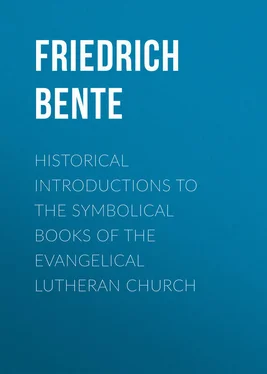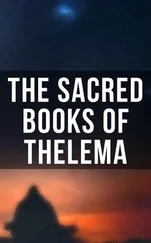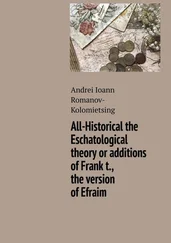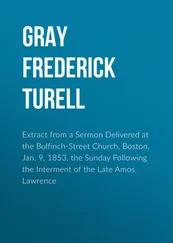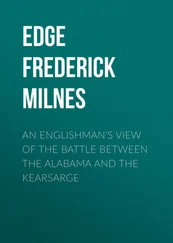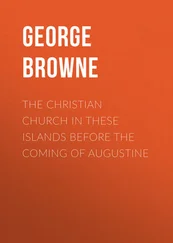Friedrich Bente - Historical Introductions to the Symbolical Books of the Evangelical Lutheran Church
Здесь есть возможность читать онлайн «Friedrich Bente - Historical Introductions to the Symbolical Books of the Evangelical Lutheran Church» — ознакомительный отрывок электронной книги совершенно бесплатно, а после прочтения отрывка купить полную версию. В некоторых случаях можно слушать аудио, скачать через торрент в формате fb2 и присутствует краткое содержание. ISBN: , Жанр: foreign_antique, foreign_prose, на английском языке. Описание произведения, (предисловие) а так же отзывы посетителей доступны на портале библиотеки ЛибКат.
- Название:Historical Introductions to the Symbolical Books of the Evangelical Lutheran Church
- Автор:
- Жанр:
- Год:неизвестен
- ISBN:http://www.gutenberg.org/ebooks/26909
- Рейтинг книги:3 / 5. Голосов: 1
-
Избранное:Добавить в избранное
- Отзывы:
-
Ваша оценка:
- 60
- 1
- 2
- 3
- 4
- 5
Historical Introductions to the Symbolical Books of the Evangelical Lutheran Church: краткое содержание, описание и аннотация
Предлагаем к чтению аннотацию, описание, краткое содержание или предисловие (зависит от того, что написал сам автор книги «Historical Introductions to the Symbolical Books of the Evangelical Lutheran Church»). Если вы не нашли необходимую информацию о книге — напишите в комментариях, мы постараемся отыскать её.
Historical Introductions to the Symbolical Books of the Evangelical Lutheran Church — читать онлайн ознакомительный отрывок
Ниже представлен текст книги, разбитый по страницам. Система сохранения места последней прочитанной страницы, позволяет с удобством читать онлайн бесплатно книгу «Historical Introductions to the Symbolical Books of the Evangelical Lutheran Church», без необходимости каждый раз заново искать на чём Вы остановились. Поставьте закладку, и сможете в любой момент перейти на страницу, на которой закончили чтение.
Интервал:
Закладка:
15. Niceno-Constantinopolitan Creed
In order to suppress Arianism, which still continued to flourish, Emperor Theodosius convened the Second Ecumenical Council, in 381 at Constantinople. The bishops here assembled, 150 in number, resolved that the faith of the Nicene Fathers must ever remain firm and unchanged, and that its opponents, the Eunomians, Anomoeans, Arians, Eudoxians, Semi-Arians, Sabellians, Marcellians, Photinians, and Apollinarians, must be rejected. At this council also Macedonius was condemned, who taught that the Holy Spirit is not God: elege gar auto me einai theon, alla tes theontos tou patros allotrion. (Mansi, 3, 568. 566. 573. 577. 600.) By omissions, alterations, and additions (in particular concerning the Holy Spirit) this council gave to the Nicene Creed its present form. Hence it is also known as the Niceno-Constantinopolitan Creed. The Third Ecumenical Council, which assembled at Toledo, Spain, in 589, inserted the word "Filioque," an addition which the Greek Church has never sanctioned, and which later contributed towards bringing about the great Eastern Schism. A. Harnack considers the Constantinopolitanum (CPanum), the creed adopted at Constantinople, to be the baptismal confession of the Church of Jerusalem, which, he says, was revised between 362 and 373 and amplified by the Nicene formulas and a rule of faith concerning the Holy Ghost. (Herzog, R. E. , 11, 19f.) Following is the text of the CPanum according to Mansi:
Pisteuomen eis hena theon patera, pantokratora, poieten ouranou kai ges, oratwn te pantwn kai aoratwn. Kai eis hena kurion Iesoun Christon ton huion tou theou ton monogene, ton ek tou patros gennethenta pro panton ton aionon, phos ek photos, theon alethinon ek theou alethinou, gennethevta, ou poiethenta, homoousion to patri, di' ou ta panta egeneto, ton di' hemas tous anthropous kai dia ten hemeteran soterian katelthovnta ek tov ouranon, kai sarkothenta ek pneumatos hagiou kai Marias tes parthenou, kai enanthropesanta, staurothenta te huper hemon epi Pontiou Pilatou, kai pathonta, kai taphenta, kai anastanta te trite hemera kata tas gpaphas, kai anelthonta eis tous ouranous, kai kathezomenon ek dexion tou patros, kai palin erchomenon meta doxes krinai zontas kai nekrous; ou tes basileias ouk estai telos. Kai eis pneuma to hagion, to kurion, to zoopoion, to ek tou patros ekporeuomenon, to sun patri kai huio sumproskunoumenon kai sundoxazovmenon, to lalesan dia ton propheton, eis mian hagian katholiken kai apostoliken ekklesian. Homologoumen hen baptisma eis aphesin hamartion; prosdokomen anastasin nekron, kai zwen tou mellontos aionos. Amen. (3, 565.)
16. The Athanasian Creed
From its opening word this Creed is also called Symbolum Quicunque. Roman tradition has it that Athanasius, who died 373, made this confession before Pope Julius when the latter summoned him "to submit himself to him [the Pope], as to the ecumenical bishop and Supreme arbiter of matters ecclesiastical ( ut ei, seu episcopo oecumica et supremo rerum ecclesiasticarum arbitro, sese submitteret )." However, Athanasius is not even the author of this confession, as appears from the following facts: 1. The Creed was originally written in Latin. 2. It is mentioned neither by Athanasius himself nor by his Greek eulogists. 3. It was unknown to the Greek Church till about 1200, and has never been accorded official recognition by this Church nor its "orthodox" sister churches. 4. It presupposes the post-Athanasian Trinitarian and Christological controversies. – Up to the present day it has been impossible to reach a final verdict concerning the author of the Quicunque and the time and place of its origin. Koellner's Symbolik allocates it to Gaul. Loofs inclines to the same opinion and ventures the conjecture that the source of this symbol must be sought in Southern Gaul between 450 and 600. (Herzog, R. E. , 2, 177.) Gieseler and others look to Spain for its origin.
Paragraphs 1, 2, and 40 of the Athanasian Creed have given offense not only to theologians who advocate an undogmatic Christianity, but to many thoughtless Christians as well. Loofs declares: The Quicunque is unevangelical and cannot be received because its very first sentence confounds fides with expositio fidei. (H., R. E. , 2, 194.) However, the charge is gratuitous, since the Athanasian Creed deals with the most fundamental Christian truths: concerning the Trinity, the divinity of Christ, and His work of redemption, without the knowledge of which saving faith is impossible. The paragraphs in question merely express the clear doctrine of such passages of the Scriptures as Acts 4, 12: "Neither is there salvation in any other, for there is none other name under heaven given among men whereby we must be saved;" John 8, 21: "If ye believe not that I am He, ye shall die in your sins"; John 14, 6: "Jesus saith unto him, I am the Way, the Truth, and the Life; no man cometh unto the Father but by Me." In complete agreement with the impugned statements of the Athanasian Creed, the Apology of the Augsburg Confession closes its article "Of God" as follows: "Therefore we do freely conclude that they are all idolatrous, blasphemers, and outside of the Church of Christ who hold or teach otherwise." (103)
In the early part of the Middle Ages the Quicunque had already received a place in the order of public worship. The Council of Vavre resolved, 1368: "Proinde Symbolum Apostolorum silenter et secrete dicitur quotidie in Completorio et in Prima, quia fuit editum tempore, quo nondum erat fides catholica propalata. Alia autem duo publice in diebus Dominicis et festivis, quando maior ad ecclesiam congregatur populus, decantantur, quia fuere edita tempore fidei propalatae. Symbolum quidem Nicaenum post evangelium cantatur in Missa quasi evangelicae fidei expositio. Symbolum Athanasii de mane solum cantatur in Prima, quia fuit editum tempore quo maxime fuerunt depulsa et detecta nox atra et tenebrae haeresium et errorum." (Mansi, 26, 487.) Luther says: "The first symbol, that of the apostles, is indeed the best of all, because it contains a concise, correct and splendid presentation of the articles of faith and is easily learned by children and the common people. The second, the Athanasian Creed, is longer … and practically amounts to an apology of the first symbol." "I do not know of any more important document of the New Testament Church since the days of the apostles" [than the Athanasian Creed]. (St. L. 10, 994; 6, 1576; E. 23, 253.)
17. Luther on Ecumenical Creeds
The central theme of the Three Ecumenical Symbols is Christ's person and work, the paramount importance of which Luther extols as follows in his tract of 1538: "In all the histories of the entire Christendom I have found and experienced that all who had and held the chief article concerning Jesus Christ correctly remained safe and sound in the true Christian faith. And even though they erred and sinned in other points, they nevertheless were finally preserved." "For it has been decreed, says Paul, Col. 2, 9, that in Christ should dwell all the fulness of the Godhead bodily, or personally, so that he who does not find or receive God in Christ shall never have nor find Him anywhere outside of Christ, even though he ascend above heaven, descend below hell, or go beyond the world." "On the other hand, I have also observed that all errors, heresies, idolatries, offenses, abuses, and ungodliness within the Church originally resulted from the fact that this article of faith concerning Jesus Christ was despised or lost. And viewed clearly and rightly, all heresies militate against the precious article of Jesus Christ, as Simeon says concerning Him, Luke 2, 34, that He is set for the falling and the rising of many in Israel and for a sign which is spoken against; and long before this, Isaiah, chapter 8, 14, spoke of Him as 'a stone of stumbling and a rock of offense.'" "And we in the Papacy, the last and greatest of saints, what have we done? We have confessed that He [Christ] is God and man; but that He is our Savior, who died and rose for us, etc., this we have denied and persecuted with might and main" (those who taught this). "And even now those who claim to be the best Christians and boast that they are the Holy Church, who burn the others and wade in innocent blood, regard as the best doctrine [that which teaches] that we obtain grace and salvation through our own works. Christ is to be accorded no other honor with regard to our salvation than that He made the beginning, while we are the heroes who complete it with our merit."
Читать дальшеИнтервал:
Закладка:
Похожие книги на «Historical Introductions to the Symbolical Books of the Evangelical Lutheran Church»
Представляем Вашему вниманию похожие книги на «Historical Introductions to the Symbolical Books of the Evangelical Lutheran Church» списком для выбора. Мы отобрали схожую по названию и смыслу литературу в надежде предоставить читателям больше вариантов отыскать новые, интересные, ещё непрочитанные произведения.
Обсуждение, отзывы о книге «Historical Introductions to the Symbolical Books of the Evangelical Lutheran Church» и просто собственные мнения читателей. Оставьте ваши комментарии, напишите, что Вы думаете о произведении, его смысле или главных героях. Укажите что конкретно понравилось, а что нет, и почему Вы так считаете.
